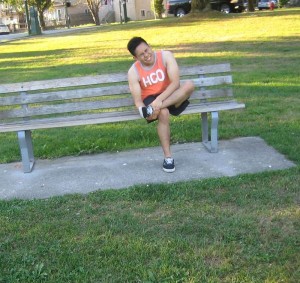A mid-tarsal joint sprain involves injury to the ligaments supporting the mid-tarsal joint. This injury results to pain in the exterior middle part of the foot.
Damage to the mid-tarsal joint is rare but can occur among gymnasts, those who engage in jumping sports and even football. The mid-tarsal joint is comprised of the talo-navicular joint amidst the talus and navicular bones and the calcaneocuboid joint between the calcaneus and cuboid bones on the exterior part of the foot.
There are 2 ligaments that are usually damaged and these might trigger slightly different symptoms:
- Calcaneocuboid ligament – connects the calcaneus and cuboid on the top part of the foot
Damage to the mid-tarsal joint is rare but can occur among gymnasts, those who engage in jumping sports and even football. - Bifurcate ligament – this is a Y-shaped ligament comprised of 2 parts – calcaneonavicular ligament and calcaneocuboid ligament.
Indications of a mid-tarsal joint sprain
The indications and severity of a mid-tarsal joint sprain depends on the ligament damaged. In most cases, pain is felt on the exterior middle part of the foot and there is swelling on the outside upper part of the joint. There is also pain during certain foot movements depending on which of the 2 ligaments are involved.
Injury to the calcaneocuboid ligament
The indications of a mid-tarsal joint sprain in which the calcaneocuboid ligament is torn results to the following:
- Pain on the exterior middle part of the foot that can occur after an ankle sprain or any injury to the ankle.
- Pain and swelling on the top and outside part of the foot
- Pain is present when inverting the foot or turning it so the soles face inwards
An MRI is usually done to confirm a diagnosis while an X-ray is done to rule out a possible fracture.
The treatment includes adequate rest as well as taping of the foot to support the joint as it heals. Applying an ice pack also reduces the pain and inflammation. The ice pack should be applied for 10 minutes every hour initially during the first 24-48 hours.
NSAIDs such as ibuprofen can be given to minimize the pain and inflammation. Orthotic inserts might also be fitted to fix biomechanical issues of the feet. In cases in which the symptoms persist, a corticosteroid injection is prescribed.
Injury to the bifurcate ligament
With this type of mid-tarsal joint sprain, it occurs after a severe ankle injury along with a fracture of a protruding part at the front of the heel bone. The usual symptoms include the following:
- Pain on the exterior middle part of the foot
- Pain is worsened if the foot is pointed down and rolling it outwards
An MRI is performed to confirm a diagnosis and an X-ray is used to determine any fractures, especially in the anterior process of the heel bone.
The treatment involves immobilization of the foot with a cast for 4 weeks. Take note that surgery might be considered for severe cases in which the bones are displaced out of their normal alignment.
Quick Note / Disclaimer
The material posted on this page on a mid-tarsal joint sprain is for learning and educational purposes only. To learn to recognize and manage sprains, register for a first aid and CPR course with Ottawa First Aid.

